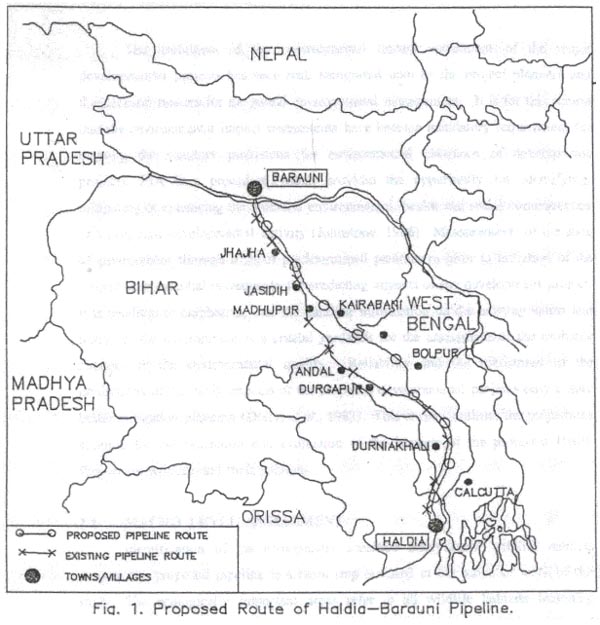Introduction
|
Expanding demand for clean burning fuel in most countries, increasing distances of gas reserves from areas of demand and rapid upgradation of existing capacities of refineries have raised the world pipeline mileage under construction to 86,000 miles (Ives, 1993). India too has made rapid strides in the development of energy generation capacity, which has gone up from 1700 MW in 1950 to over 6700 MW today (Anon, 1992) the ever increasing demand for commercial energy and modern fuels has led to unprecedented expansion of pipeline network for the transportation of crude and refined petroleum products. The pipeline transportation era which began in early sixties in India has since then resulted in a 7800 km network of pipeline for transporting crude, natural gas and refined petroleum products. The further expansion of these pipelines became inevitable to meet the growing demands of crude and finished petroleum products that provide power and energy for the country's industrial growth. As a result of this, contracts for upgrading the expansion by additional 7865 km of pipelines have already been finalised by three of the countries leading oil companies - Oil and Natural Gas Commission (ONGC), Gas Authority of India Limited (GAIL) and Indian Oil Corporation Limited (IOCL). Some of these projects for pipeline expansion are already underway (Ives George, 1993) and others are likely to be completed within a span of five years. It is obvious that these expansions into the urban areas would become constrained for want of space. The certainty of conflicts that would result from their expansion into areas earmarked for urban development facilities like rails, canals and transmission lines would move these expansions further into remoter parts of the country. Though the pipelines are by far the most superior mode of transport as these involve lower cost of transportation, conservation of fossils fuels, minimum product loss during transit and reduced pressure on rail and road transportation, yet these can have considerable impacts upon the environment and the aquatic and terrestrial wilderness values of the areas that are located enroute these linear developments (WII, 1993). Most of these environmental concerns arise from the choice of route and construction technology, pipeline design and activities associated with construction and post construction phase maintenance. The environmental challenge is therefore to identify the potential impacts of proposed linear expansions of pipelines and to develop safeguards that will enable expansion to take place without significant damage to natural environment, and consequent effects on the people and wildlife that it supports. 1.1 THE PROPOSED PROJECT The capacity of existing Haldia - Barauni pipeline for products is 1.4 MMTPA which will get reduced to 0.9 MMTPA with existing facilities if the crude oil sought is to be transported through it, due to higher viscosity of crude oil as compared to that of products. Hence if HBPL is converted to crude service, the additional availability of crude oil at Barauni would be only to the extent of 0.9 MMTPA. While this will meet the immediate requirements of Barauni Refinery, this may cause serious logistics constraints in maintaining the supply and distribution of products in Eastern Sector. This will be due to the fact that upon conversion of HBPL to crude service, the incremental yield of middle distillates from the processing of 0.9 MMTPA, additional crude would be barely 0.5 MMTPA. Hence, nearly 0.9 MMTPA (1.4 - 0.5) of kerosene and Diesel will have to be moved over long distances by rail from Haldia to meet the deficits. This would be both uneconomical and cumbersome. Further, the conversion to crude services will not take care of potential expansion of Barauni Refinery to 4.2 MMTPA and would not act as a long term solution to meet the additional crude oil requirements of Barauni Refinery. Considering the drop in the crude oil being received from Assam it is visualised that this availability would be only limited to 2.4 MMTPA. The Barauni Refinery would be expanded to a level of 4.2 MMTPA. Supply of additional crude oil requirements to Barauni Refinery through new pipelines would be more cost effective. 1.1.1 PROJECT SETTING
1.1.2 PROJECT DESIGN 1.1.3 SALIENT FEATURES OF THE PIPELINE Despatch terminal: Haldia Receiving terminal: Barauni Intermediate station: Dhubrajpur (240 km from Haldia) Product to be transported: Crude oil Outer diameter of pipeline: 18" Total length of pipeline: 555 km Length of pipeline through existing Right of Way (ROW): 185 KM Flow rate Stage I : 270 m3/hr Stage II : 495 m3/hr Stage III : 630 m3/hr Operating temperature: Ambient 1.2 ENVIRONMENTAL IMPACT ASSESSMENT AND SCOPE OF WORK 1. To assess the existing status of wildlife species and habitats (terrestrial, avian and aquatic) along the proposed pipeline route. 2. To identify the likely impacts on wildlife and their habitats. 3. To assess and evaluate the impacts of the proposed HBPL project on the Reserved Forest/Forests enroute. 4. To identify the ecologically sensitive areas/ecosystems/ habitats (marshy areas, wetlands) and the endangered species that may be impacted due to the proposed pipeline. 5. To suggest mitigatory measures for the likely impacts that may be caused by the proposed pipeline. 6. Outline legal/statutory obligations to be fulfilled by the Project authorities under the Forest (Conservation) Act as amended in 1992 and Wildlife (Protection) Act, 1972. |
Last Updated: October 7, 2015










